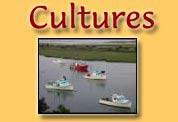|
Culture |

CULTUREMissed from the olden days say long-time residents in these villages is a sense of community provided by pulling together to run a volunteer fire department, to help each other through bad times and good, to chat with each other at the local store, playing music and games together. "They were strong people back then living off the land. They never had much money but always had something to eat," says Ron Slaunwhite of Terence Bay. People lived close to nature and related to each other with a sense of peace and completeness. The social life included lots of music, singing and dancing which all communities enjoyed. Wind watching fishing communities frequently were perched on cliffs or ledges facing the sea. Houses anchored to the ledges were safe from the closeby grinding, unpredictable sea. Systems of paths, trails, boardwalks and bridges accompanied development of the fishing villages which were isolated from each other. For many years these communities conducted all communication by sea. Sturdy, courageous, self-reliant and adventurous fishers worked at sea in the season from early in the morning until late in the afternoon. Thick Irish sweaters kept them warm and snug. Life for the hardy, versatile, skillful seacoast women revolved mostly around child rearing and homemaking, baking bread, peeling potatoes, sewing clothes and doing the laundry. Women who migrated particularly to Newfoundland in the earliest days, formed part of the fishery shore crew, as cooks and as serving women. In 1805, of 583 Irish passengers to Newfoundland, 76 were women. Reasons for settlers to leave their homeland and strike out to unknown territory include those of a religious, political, economic and social nature. There were financial and land ownership opportunities in British North America. Employment problems, overpopulation, low wages, and intolerable conditions at home motivated migration. However, a key motivation was land ownership, something few could ever do at home. In several areas the people could not possess farms, inherit or own a home. In many places people of certain religious beliefs could not vote. They could also be forced into military service. Crop failure and famine in the 1800s in Ireland also caused a wave of immigration. In the 1750s, the British government began convincing families to emigrate to Nova Scotia. They particularly wanted those who were loyal to the British crown, no older than fifty, and Protestant. Large numbers of Swiss, French and German chose to make the move to Nova Scotia and became known as the "Foreign Protestants." Adding to the mix were New Englanders who arrived in the 1760s with a strong sympathy with those in the colonies desiring independence from England. Immigrants from Yorkshire in the 1770s had strong feelings of patriotism towards Britain. Many ships sailed to the New World with human cargo in miserable circumstances, a journey of 9 to 13 weeks. In some cases passengers served as ballast or as indentured passengers trading their labour for several years (chopping down trees, constructing buildings and clearing land) in return for passage. There was no free passage. Many had to work off the cost of the journey after arriving. Eventually this debt was cancelled because the settlers expressed great difficulty in paying it while taking care of their own families at the same time. Each of these families received a grant of 50 acres free from rent or tax for 10 years. For every dependent in a family an additional 10 acres were granted and this allotment grew with each new birth. They were given arms to defend themselves and ammunition along with tools for homesteading. Culture of the Past:Mi'kmaq used to camp on these shores. Proud hunters and fishers, they used a process involving the bark of trees to prevent their fishing nets from rotting in salt water. They boiled together bark and fish guts until the bark drew the fish oil out of the guts. Then the nets were soaked in the oily solution that acted as a barrier against the seawater. Their industries included basket making, quill work, leatherworking and beautifully embroidered clothing. Early trails used by the settlers were the paths of the Mi'kmaq. Teaching the earliest settlers about the local flora and fauna, these people also showed the settlers how to use the weir to fish. They also pointed out the values of locally wild herbs for medicine and plants for food. Many of these people spent their summers fishing and hunting on the the islands, coves and inlets along these shores. Nicholas Denys wrote in the 17th century about the native cooking method for meat or fish: "To roast the meat they cut it into fillets, split a stick, placed it therein, then stuck the stick in front of the fire, each person having his own. When it was cooked on one side, and in proportion as it cooked, they ate it. Biting into it, they cut off the piece with a bone, which they sharpened on rocks to make it cut.." |
